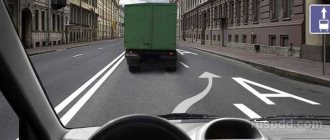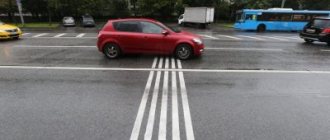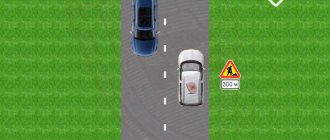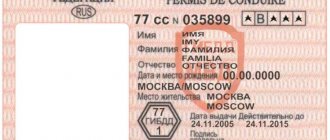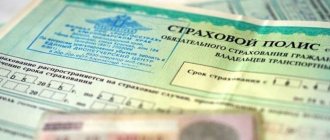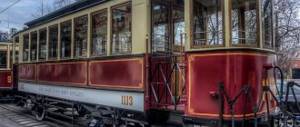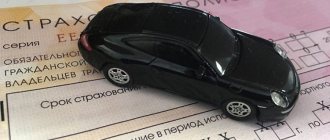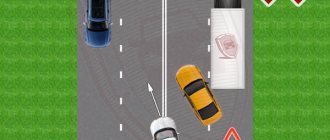What law regulates the rules for crossing railroad crossings?
To ensure an increased level of safety when crossing crossings, a huge number of protective systems are used. However, they are also powerless against reckless drivers or drivers who neglect the simple rules for driving on such sections of the road.
The main legal act, which specifies the main points for the passage of railway tracks, is the Traffic Rules.
Naturally, this topic is given a separate chapter, number 15, in a large set of rules.
Thus, it regulates:
- use of markings, road signs, light signals or a responsible employee;
- situations in the event of which it is strictly prohibited for vehicles to enter the crossing, as well as for pedestrians to enter the crossing;
- the possibility of parking for a long time or stopping for a few minutes for vehicles in the immediate vicinity of the crossing;
- rules that the driver, as well as his passengers, must know and follow in the event of an unexpected stop of the car at the crossing itself.
In the event of an intentional or unintentional violation of the rules prescribed in the traffic rules, the person driving the car is held accountable on the basis of Chapter 12 of the Code of Administrative Offenses of the Russian Federation.
Equipment for railway crossings
From a historical perspective, it has been repeatedly changed and updated. At first they were served by signalmen, but the need quickly arose to use not only human labor, but also barriers. It was necessary to build a physical barrier to facilitate the movement of livestock. Therefore, they came up with special gates that were activated manually, and then automatically, and stopped the herd. The peak of their relevance came at the end of the 19th century.
The need for such barriers became less urgent at the beginning of the 20th century, with the widespread use of passenger cars. There has been a replacement - in favor of light signals and barriers. The latter were used where it was impossible to rely only on the consciousness of the drivers. Their first models were lifted by maintenance personnel and blocked the entire lane, later ones became electronic and already began to occupy half of the track.
Today, signs are installed everywhere: an oblique (St. Andrew's) cross, a white triangle with a red border, and others. It is also common to use traffic lights with synchronous sound warnings or even alarming infra-acoustics.
Features of railway crossing equipment in different countries
As contrasting examples, let's take Belgium and the Netherlands - both states with a developed and very dense road network, which means with a large number of intersection points and with the following nuances:
- all transitions are automated - manual ones remain only on branches of historical significance;
- it is prohibited to build new ones; when repairing old ones, damaged elements are replaced with overpasses;
- There are already five categories according to workload, and not four, as in Russia;
- Since the beginning of the 2000s, there has been a tendency to reduce their number (especially in groups IV and III) with the simultaneous modernization of the remaining ones - in order to minimize the number of accidents and accidents.
Railroad crossing signs
| 1.1 | “Railway crossing with barrier” Installed: In a populated area 50 – 100 meters; Outside the populated area 150 - 300 meters. |
| 1.2 | “Railway crossing without a barrier” Installed: In a populated area 50 – 100 meters; Outside the populated area 150 - 300 meters. |
| 1.3.1 | “Single track railway” Installed: Just before the move. |
| 1.3.2 | “Multi-track railway” Installed: Just before the move. |
| 1.4.1 1.4.2 1.4.3 1.4.4 1.4.5 1.4.6 | “Approaching a railway crossing” The fewer stripes on the sign, the closer the crossing. |
Railway crossing diagram
In general, it looks like this:
Please note that a post (1) is equipped; railings (2) and posts (9) are used as fencing elements. The flooring (12) is made of reinforced concrete slabs for maximum reliability. An automatic one (3) is used as the main barrier; the spare ones (4) are manual. There are all the necessary warning signs: “C” (13), “Beware of the train” (6) and others. Tubes (10) are provided for installation of portable alarm systems.
Sign 1.1 “Railway crossing with barrier”
Road sign 1.1 “Railway crossing with a barrier” warns drivers about approaching a railway crossing that is equipped with a barrier.
Outside a populated area, sign 1.1 is installed at a distance of 150-300 m, in a populated area - at a distance of 50-100 m. The sign can also be placed at a different distance, and the sign is used with the sign 8.1.1 “Distance to the object”.
Main characteristics of sign 1.1
According to the traffic rules, the railroad crossing road sign, designated 1.1, is a warning sign.
And if a motorist meets him on the road, it will mean that he is approaching the intersection with a railway track that has a barrier. Since this sign has a warning definition, it is framed in red. It has the shape of a triangle, looking at an acute angle upward, with the image of railway tracks on a white background.
The driver, when he encounters such a sign, must slow down and be prepared for the fact that the barrier at the crossing may be closed. This means that you will have to wait for some time until the locomotive passes this section of the route.
Then the road will again become open for vehicles, and they will be able to cross the railway track without hindrance.
Such signs, which are located outside populated areas, must be repeated a total of at least 6 times. This is done in order for the driver to show maximum attention and vigilance when approaching a rather dangerous section of the road.
Sign 1.3.2 “Multi-track railway”
Signs “Single-track railway” and “Multiple-track railway” are installed in front of all railway crossings without a barrier, across a railway with one or two or more tracks, respectively.
When the crossing is equipped with a traffic light signal, the signs are installed on the same support as the traffic light, and if there is no traffic light, then they are placed at a distance of 6 - 10 meters from the nearest rail.
Signs 1.4.1 - 1.4.6 “Approaching a railway crossing”
These signs serve to further inform drivers about the degree of approach to a railway crossing outside a populated area.
Signs 1.4.1 - 1.4.6 “Approaching a railway crossing” are installed on roads with two or more lanes for traffic in both directions before each crossing, and on roads with one lane - when the visibility distance of the crossing is less than 300 m.
Signs 1.4.1 - 1.4.3 are installed on the right side of the road, and signs 1.4.4 - 1.4.6 - on the left.
Signs 1.4.1 and 1.4.4 (with three stripes) are installed with the first (main and backup) sign 1.1 or 1.2 in the direction of travel, signs 1.4.3 and 1.4.6 (with one stripe) - with a repeated sign 1.1 or 1.2, and signs 1.4.2 and 1.4.5 (with two stripes) - independently, at an equal distance between the first and repeated sign 1.1 or 1.2.
The diagram shows that signs 1.4.1, 1.4.3, 1.4.4 and 1.4.6 are placed under sign 1.1 or 1.2, signs 1.4.2 and 1.4.5 are located between them. They are placed at a height equal to the height of installation of signs 1.4.1, 1.4.3, 1.4.4 and 1.4.6.
Thus, if on your way you come across a combination of signs 1.1 “Railway crossing with a barrier” or 1.2 “Railway crossing without a barrier” with signs 1.4.1 or 1.4.4 (with three inclined stripes), then before the railway crossing you There is a minimum of 150 and a maximum of 300 meters left.
It immediately becomes clear (from the image on the sign) which railway crossing is ahead - with or without a barrier. Accordingly, it makes sense to pay attention to the organization of passage through the railway tracks, and be prepared, if necessary, to stop at the place established by the traffic rules.
Considering the speed of the car, you can drive directly to the crossing very quickly. I recommend the article (answer to the question) Stop line before a railway crossing.
Railway crossing: what is it?
According to various definitions, this is the point at which the railway track intersects at the same level with the road for:
- passage of cars, motorcycles, bicycles and other urban transport;
- the passage of pedestrians and the passage of livestock;
- movement of special equipment, agricultural, horse-drawn, self-propelled vehicles.
The specific location of its construction is determined by the head of the line. But wherever it is located, it is considered an object of increased danger, which should be created in areas with good visibility and equipped with additional devices - barriers, traffic lights, and so on - to minimize the likelihood of accidents and prevent accidents.
A variety of requirements can be placed on a railway crossing scheme, but the two main criteria are:
- good condition of all elements and functional units;
- sufficient visibility at any time of the day.
The last condition is satisfied in cases where a person located at a distance of 50 m from the point in question is visible to transport approaching from any direction at least 400 m away, and the driver’s view extends at least 1 thousand m.
Usually the intersection of two roads - railway and road (or another) - is carried out at a right angle, but in difficult conditions it can be reduced to 60 degrees.
It is permissible to arrange a crossing only where it does not reduce the useful length of the track and does not interfere with the duration of the running and exhaust parts. But doing it from the traction facilities in the necks is no longer recommended, because these are the busiest points where there is not only constant movement, but also active shunting work.
The optimal location within the station is between the switch and the input signal: thanks to this solution, cars will be able to pass freely if the locomotive stops.
The minimum distance to the turnout is 5 m, if you count from the root of the switch cross; this will help prevent clogging of the moving elements of the transition device. The distance from the end of the platform for passengers is at least 100 m to prevent accidents.
Rail crossing options
In order to master the important rules for traveling railway tracks, you should know that all areas of this type equipped on routes are divided into several categories:
- With the implementation of traffic regulation, that is, regulated.
- Crossings where traffic regulation is not carried out, that is, unregulated.
The first category includes sections where the road intersects with railway tracks, which are equipped with one of the following devices:
- illuminated signs;
- mechanical barrier;
- mechanical fences that perform shockproof function.
This list can also include an employee who is on duty directly at the crossing.
Stop before the railway crossing
0 10448 The railway crossing area is quite dangerous, since trains move there at high speeds, and motorists are constantly in a hurry and even break the rules so as not to stand waiting...
- Read more -
Under what conditions are they arranged?
The fencing device at railway crossings is a set of means that are aimed at guaranteeing the safety of the movement of rolling stock, automobiles and other vehicles, as well as the safety of cargo, passengers and eliminating threats to the life and health of citizens.
The conditions that must be met when installing barriers on a railway are as follows:
- the barrier beam must stably block the passage when in the closed position;
- the required sufficient force used to switch the barrier to different modes (open, closed);
- the barrier beam must be held stably in the open passage position;
- the ability to stop the barrier during the closing process when various obstacles arise, as well as continue closing after the obstacle disappears;
- the barrier must fold at a right angle (automatic, manual mode) when a vehicle hits it in the closed position;
Requirements for railway crossings
0 15275 Railway crossings are places where trains and locomotives, as well as automobile and other transport, move.
The requirements for railway crossings are to equip them with the appropriate devices (barriers and others) and... — Read more —
Passage of controlled railway crossings with barriers
Any controlled crossing over railway tracks is indicated by different road signs depending on whether it has a barrier or not and how far away it is.
Approaching a railway crossing:
- The first sign is installed 150-300 meters from the crossing. At this distance, overtaking is only allowed for cars moving at low speeds.
- The second sign is installed at a distance of 100-200 meters from the danger zone. Overtaking is prohibited from this distance.
- The third sign indicating the approach to the railway crossing is located 50-100 meters from the crossing. In addition to the ban on overtaking, there is a ban on parking of vehicles.
Signs and approach distances to railway crossings.
Instructions for safety on railway tracks
INSTRUCTION ON SAFETY RULES ON RAILWAY TRANSPORT INFRASTRUCTURE
The following rules must be observed on the railway transport infrastructure:
Cross railway tracks only in designated places, using viaducts and crossings.
Before crossing the tracks on the pedestrian deck, you must make sure that there is no moving train, locomotive or carriage (the dangerous distance is considered to be 500 meters).
When a train, locomotive or carriage approaches, you should stop, let them pass and, after making sure that there is no moving rolling stock on adjacent tracks, continue crossing.
When approaching a railway crossing, citizens should carefully monitor the light and sound alarms, as well as the position of the barrier. You can cross the tracks only if the barrier is open, and if it is not there, before crossing the tracks, you need to make sure whether a train, locomotive or cars are approaching the crossing.
PROHIBITED:
Walk along the railway tracks. Sit on the rails.
Cross and run across railway tracks in front of a nearby train if the distance to it is less than 500 meters.
Cross the tracks immediately after a train passes, without making sure that there is no train in the opposite direction.
Cross railway crossings when the barrier is closed or the crossing signal is showing a red traffic light.
At stations and stages, crawl under the cars and climb over automatic couplers to pass through the track.
Walk along the railway track closer than 5 meters from the outermost rail.
Walk across railway bridges and tunnels that are not equipped with paths for pedestrians.
Climb under a closed barrier at a railway crossing, and also go out onto the crossing when the barrier begins to close.
PASSENGER SAFETY RULES:
Boarding (disembarking) should only be done after the train has come to a complete stop.
Exiting and boarding cars must be done only from the side of the platform or boarding platform. Hold young children by the hand or in your arms.
PROHIBITED:
Drive on the roofs, steps, and transition platforms of carriages.
boarding and disembarking while the train is moving.
Leaning out of carriage windows and vestibule doors while the train is moving.
Stand on steps and transition platforms, open carriage doors while the train is moving, delay the opening and closing of doors on commuter trains.
Travel on freight trains without special permission.
Traveling on trains while drunk.
leave children unattended on boarding platforms and in carriages.
Get out of the car at the intertrack and stand there as an oncoming train passes. Jump from the platform onto the railway. ways.
Organize various outdoor games on passenger platforms.
Run along the platform next to the carriage of an arriving or departing train, and also be closer than two meters from the edge of the platform while the train passes without stopping.
Approach the carriage until the train stops completely.
Arbitrarily, unnecessarily stopping the train.
The following are familiar with the instructions:
Instructed by: _____________________ /_________________________/
Date of____________________________
Rules for crossing an unregulated railway crossing
Movement along a section of road with an unregulated intersection of tracks is carried out on the basis of the following rules:
- When approaching an intersection with railroad tracks, the driver must resort to reducing speed as much as possible.
- Before crossing the tracks, the person driving the car must independently assess the traffic situation and make sure that no train is approaching the crossing.
- It is strictly forbidden to continue moving towards a crossing if there is a traffic jam at it.
When approaching an unregulated intersection with railway tracks and when a train is approaching the intersection at a visible distance, the driver is responsible for stopping the vehicle at a safe distance. Ten or more meters is considered the best option.
Rules for crossing railway crossings
0 10954 Railway crossings are areas of increased danger for motorists, since trains pass through them at high speed, which cannot stop instantly and for this they at best...
— Read more —
Rules for crossing a controlled railway crossing with a barrier
There are two basic and very important safety rules that should be followed when there is a regulated railway crossing with a barrier ahead:
- Stop the vehicle at a distance of at least 5 meters when the barrier begins to lower or is already lowered.
- Continue driving only when the mechanical device is fully raised.
Most of the barriers that are installed in Russia operate automatically. That is, their closure begins from the moment the train crosses the one kilometer mark to the nearest intersection with the highway.
However, it is possible to encounter devices at controlled crossings, the operation of which is the responsibility of the crossing duty officer. It is the person who lowers the barrier when approaching the train crossing.
In both the first and second cases, the driver is strictly prohibited from interfering with the operation of the barrier and independently opening traffic on such a dangerous section of the road. Severe punishment is provided for such actions.
Categories of railway crossings
There are 4 of them, and they, in fact, coincide with those groups in terms of load levels that we have already discussed above.
- I – For intersections with streets and highways with active and regular traffic of buses, trolleybuses, trams, areas where 4 or more main lines converge.
- II – Relevant for the same cases, but with lower traffic intensity (up to 8 units/hour at peak times.
- III – Here the indicators are even more gentle; for example, the minimum daily work rate is a relatively modest 10,000 train crews with good visibility and only 1,000 with unsatisfactory visibility, but the device for crossing the railway in this case may not meet the same high requirements as in the two previous ones.
- IV – Includes all other objects, usually used in low-activity areas.
Please note that during the planned replacement of VSP elements from the first two categories, overpasses are already laid. Because it is strictly forbidden to build new ones or renew communications along old and insufficiently reliable ones. At the same time, representatives of groups I and II are almost always serviced around the clock and are guarded, so any malfunctions are detected by those on duty relatively quickly.
Rules for moving a railway crossing when you have to stop at it
If you are forced to stop at a railroad crossing and the vehicle stalls while crossing the railroad tracks, it is necessary to remove it from the rails as soon as possible. But before this, the emergency alarm must be turned on, and all passengers, if any, must be disembarked and taken out of the danger zone. Then you need to contact the attendant and have the vehicle towed with the help of other motorists.
There are situations when the car is the only one on the road, and you can’t start it with the handbrake. Then it is necessary to send two assistants to different directions of the railway tracks at a distance of about a kilometer in order to signal the driver about the incident. They represent circular movements of the hands with a red flag or any other red material. At night, a lantern is used instead of a cloth. If there are no assistants, you should use Morse code and start broadcasting the letter “B”. It consists of one long and three short beeps and means trouble.
When crossing railway crossings, you should always remember the full extent of the possible injury hazard of this event. A train weighs many times more than a car; a braking distance of several meters is clearly not enough for it. Although the legislation of our country is doing its best to reduce the number of accidents in any situation, personal care and responsibility have never failed anyone.
Classification of railway crossings
Several important indicators are highlighted at once.
The first is the place of arrangement (consumption category), and there are two options for it:
- Public use - highways and other paths intersect with streets, municipal roads, and highways.
- Non-general - here there is already a junction with the branches of transport systems of all kinds of enterprises - both industrial and not (the organizational and legal form in this situation does not play a primary role).
Although the conditions for servicing such facilities are determined by the track manager, all issues regarding their equipment and maintenance in the second case are the concern of those organizations that directly operate them.
Attention, points located in elevators, warehouses, depots - in general, on the territory of companies - are not subject to registration by Russian Railways, as they are considered technological passages.
When thinking about the arrangement of a railway crossing, remember that according to the method of control it can be:
- Adjustable - equipped with an alarm system that promptly warns drivers about the approach of rolling stock, and/or serviced by station (road section) staff. Workers must meet the requirements of clauses 1.7 and 1.8 of the RF Railways PTE and act in accordance with the instructions.
- Unregulated - there are no warning systems, switching “from above” is not carried out. The owner of the vehicle makes decisions based on signs and traffic rules.
According to intensity (degree of load) there are 4 groups:
- I – from 39-52 trains and 501-1001 vehicles daily; the minimum quantity is determined by who or what exactly is being transported - if it is people or slags, fiery liquid metals and other cargo, a lower frequency is acceptable.
- II – from 8-24 or 25-38 trains and 501-1001 private vehicles, respectively.
- III - already from 8, 8-24 and up to 39-52 and 100, 101, 500, 501-2000 traffic participants.
- IV – all others, including those created for mobile tracks in various open areas (for example, at mining sites).
We will look at this classifier in more detail in the “Categories” section.
There are also lines with and without security. The former are serviced around the clock, and the duties of those on duty monitoring their condition include raising and lowering the barrier, giving signals, troubleshooting, monitoring passing trains and taking measures to stop them if there is a threat of an accident.
Fines for violating railway rules
Any violation of traffic rules entails liability. In the situation under consideration, when the rules of movement across railway tracks are violated, attention should be paid to the sanctions of article No. 12.10 of the Code of Administrative Offenses of Russia.
It is she, or rather its first part, that states that the recovery of an amount of one thousand rubles from the violator at the expense of the state is threatened for:
- passage of a section of railway tracks in the absence of an equipped special place for this purpose,
- crossing such a section of the road with a mechanical barrier lowered or starting to lower,
- when the prohibiting signal is on on the lighting device,
- the duty officer signals a traffic ban,
- the car parks or stops directly on the railway tracks.
The same action may well be classified by traffic inspectors as a particularly malicious violation of law and order.
In this case, the culprit will be deprived of his driver’s license for a period of one quarter to six months. As you can see, violations of this kind are punished very strictly. For this reason, even when moving along a road located far from federal highways, but with an intersection where railroad tracks cross an ordinary gravel road, it is better to strictly follow the rules. Perhaps, somewhere nearby there is a crew of traffic police officers who will immediately punish the offender.
Speaking of the problem, when a driver allows a car to leave a crossing that a train is approaching, or when behind such a section of the road there is an obstacle to further movement - a traffic jam, then one should expect penalties provided for in Part 2 of Article 12.10 of the Code of Administrative Offenses of the Russian Federation.
Violations of the rules for traveling railway tracks, with the exception of those situations described in the first part, entail a penalty equal to one thousand rubles.
If the violator does not heed the requirements of the law and is caught committing a repeated offense that falls within the scope of this article, he may be subject to an unalternative punishment in the form of a one-year deprivation of his driver's license.
Fine for driving through railway tracks at a red light
The rules for driving a railway crossing require that the driver stop before the appropriate traffic light. A fine is imposed for violation.
The punishment for driving through a red prohibitory signal is regulated by Article 12.10 of the Code of Administrative Offenses of the Russian Federation. The driver may receive the following penalties:
- a fine of 1000 rubles;
- deprivation of rights for a period of 3 to 6 months.
These measures are taken not only because of crossing a red light. A driver can receive the same punishment for disobeying a signal from an officer on duty, whose powers are equivalent to those of a traffic controller. You cannot start driving if the traffic light is red and the barrier has just begun to close or is already closed - this article of the law is applicable in these cases.
Fine for overtaking at a railway crossing
Overtaking at a railway crossing is prohibited - this is clearly stated in paragraph 11.4 of the traffic rules. There is no penalty for this violation if the driver managed to complete overtaking 100 m before the start of the crossing.
The fine for violating this rule is regulated by Art. 12.15 Code of Administrative Offences. The penalty ranges from 1000 to 1500 rubles. Depending on the circumstances, your rights may be revoked. The law applies to cases where the driver drove into oncoming traffic.
If, when driving across railway tracks, you had to pass another vehicle without leaving your lane, the punishment does not include deprivation of your license - only a fine. There will be no penalty if you had to go around any object or obstacle, but not another vehicle.
Fines for stop lines near railway tracks
The stop line, or marking 1.12, indicates where the vehicle stops. However, the driver is not always required to stop, but only in the following cases:
- if there is a sign “Driving without stopping is prohibited”;
- at a red traffic light.
The fine for hitting a stop line is prescribed in Art. 12.10, part 2 of the Code of Administrative Offenses of the Russian Federation. It is 1000 rubles. If the driver drives further, he may be subject to deprivation of his license for up to six months.
If the railway passes through a red light repeatedly, the penalty becomes more stringent: the period of deprivation of a driver’s license doubles.
Fine for crossing railway tracks at a red light
0 5717 Penalties for crossing railway tracks at a red light are the least negative consequence in the case of this violation.
The driver is highly discouraged from allowing him, primarily because for him... — Read more —
